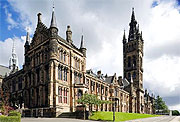Source: University of Glasgow
Notable People
Frederick Soddy
-
Frederick Soddy

-
Frederick Soddy Plaque

Source: University of Glasgow
-
Frederick Soddy

Source: University of Glasgow
-
Frederick Soddy lecture advertisement, 1906

Source: University of Glasgow
-
Soddy Radiation Apparatus

Source:
Chemist
Born 2 September 1877.
Died 22 September 1956.
A Nobel prizewinning chemist, honoured for his discovery of isotopes.
Connection to the University of Glasgow: Honorary Graduate, Lecturer
GU Degree: LLD, 1934;
Discover more chemists on the University of Glasgow Story website
Achievements
The following achievements are associated with Frederick Soddy:
Discovery of Isotopes
The value and use of isotopes in research and their importance in technology and applications to society today would have astounded Soddy.
Discovery of Protactinium
Protactinium is a chemical element with the symbol Pa and atomic number 91. It was discovered by John Arnold Cranston.
Discovery of the inert gaseous elements in air, and determination of their place in the periodic system
William Ramsay published several notable papers on the oxides of nitrogen in the 1880s and followed those up with the discovery of argon, helium, neon, krypton, and xenon in the 1890s.
Honours
The following honours are associated with this person:
Biography
Frederick Soddy (1877-1956) was a chemist who lectured at the University of Glasgow before the First World War, and won the Nobel Prize in Chemistry in 1921.
Born in Eastbourne on 2 September 1877, he was the youngest son of Benjamin and Hannah Soddy. He was educated at private schools and then attended Eastbourne College (1892-94), University College of Wales, Aberystwyth (1894-1895) and the University of Oxford, where he gained Postmastership at Merton College and graduated with first class honours in 1898.
Soddy worked as a research assistant at Oxford until 1900, when he then spent two years at McGill University in Canada, lecturing in Chemistry and working with Sir Ernest Rutherford on radioactivity, and then with Sir William Ramsay at University College, London. He moved to Glasgow in 1904 as a lecturer in Physical Chemistry and Radioactivity, and it was during his ten years at the University that he completed his most important research into the chemistry of radioactive elements.
Working with collaborators including the laboratory assistant Alexander Fleck (who later rose to become Chairman of ICI), Soddy developed the "Displacement Law" - that, "when an alpha or beta ray is emitted, the element moves to a different place in the periodic table." In 1913 he formulated the concept of "radio elements chemically non-separable" which, at the suggestion of Dr Margaret Todd, a fellow guest at a dinner party in his father-in-law's house at 11 University Gardens, he named "isotopes".
Soddy left the University in 1914 to the Chair of Chemistry at the University of Aberdeen, and in 1919 became Dr Lee’s Professor of Physical and Inorganic Chemistry at the University of Oxford, a post that he held until his retirement in 1936.
During his career he achieved a number of honours. In 1910 he was elected Fellow of the Royal Society, and as mentioned above in 1921 he was awarded the Nobel Prize in Chemistry for the discovery of isotopes. He was the first English-born Chemist to receive this honour. In 1923 he was awarded the Cannizzaro Prize in Rome, and in 1936 he was awarded an Honorary LLD by the University of Aberdeen, and was also made a Foreign Member of the Swedish, Italian and Russian Academies of Science.
Soddy died in Brighton on 22 September 1956, aged 79. By his will, he established the Frederick Soddy Trust to provide grants to "groups studying the whole life of a community."

